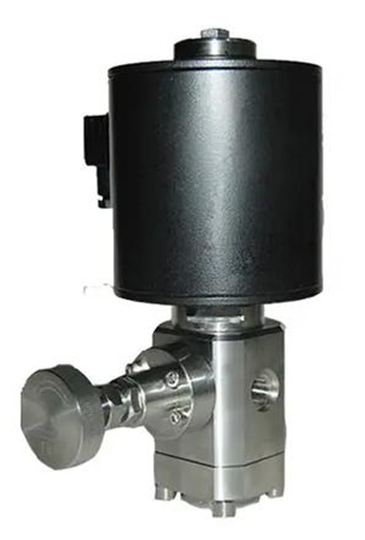Magpie Valve Selection: Accurate Matching Ensures Reliable Control
Valve Technology Sharing
Dual-Electric Control Design of High-Pressure Shut-Off Valves and Field Application
"Low Power Consumption + Remote Control" Solution for Off-Grid High-Pressure Valve Operation

Continuous Power Consumption: Traditional single-electric control solenoid valves maintain valve position by continuously energizing the coil (e.g., powered-on to open, powered-off to close). In off-grid scenarios relying on solar panels and batteries, this continuous power draw causes:
Solar panel capacity must match continuous consumption (e.g., a 20W coil consumes 0.48 kWh/day), requiring ≥100W solar panels and 12Ah batteries.
Battery capacity must be oversized, increasing equipment size, transportation costs, and reducing battery lifespan due to temperature sensitivity in harsh environments.
Limited Remote Control: Single-electric control valves can only be toggled by switching power on/off, lacking the ability to receive pulse signals. Remote control systems must maintain continuous current output, leading to poor compatibility and potential communication module overload, especially in low-power IoT scenarios.
Dual-Coil Function: Separate coils for "open valve pulse" and "close valve pulse," eliminating continuous power consumption.
Opening Action: A short pulse (e.g., 24V DC for 0.5 seconds) energizes the "open coil," electromagnetically actuating the valve core to open. After positioning, the coil powers off; a spring in the single-acting cylinder holds the valve open without continuous power.
Closing Action: Similarly, a short pulse energizes the "close coil," overcoming spring force to close the valve. After closure, coil power stops, and the spring holds the valve shut. Average power consumption is <0.1W, limited to momentary pulses.
Key Advantage: Instantaneous pulse power replaces continuous power, reducing energy consumption by over 90%.
Example: A single-electric valve operating once per day consumes 0.48 kWh daily; the dual-electric valve consumes only 0.003 kWh per pulse (coil resistance 100Ω, 0.5-second pulse), resulting in <0.01 kWh daily or 1/50th the energy consumption annually.
Power demand drastically reduced: Dual-electric valves require <0.1W average power, enabling use of 20-30W solar panels and 5Ah lithium batteries (versus 100W+12Ah for single-electric), lowering costs by 60% and size by 70%. Solar panels can be integrated into valve supports; batteries withstand temperatures from -40°C to 85°C.
Energy Management Logic:
Daytime: Solar panels charge batteries and supply real-time pulse power, minimizing battery discharge.
Night/Rainy Days: Batteries only support occasional pulse commands (e.g., 5 operations/day), allowing >30 days autonomy without sunlight, avoiding battery depletion common in continuous power schemes.
Pulse signals are compatible with low-power IoT protocols such as LoRa and NB-IoT. Remote systems send "open/close pulse commands" with single transmission power consumption under 1 mWh, replacing continuous current output and suiting remote, no-base-station environments like oil fields and long-distance pipelines.
Enhanced Safety Cut-Off:
Supports "dual-signal trigger" shutoff, e.g., remote close pulse plus local pressure sensor overpressure confirmation, preventing false triggering common in single-electric valves due to signal interference.
Offline/Emergency Operation: Built-in supercapacitors store the last pulse, enabling manual control via handheld Bluetooth terminals even if solar panels fail, improving field maintenance.
Single-acting cylinder ensures fail-safe operation: Dual-electric valves use spring-return cylinders, holding valve open or closed regardless of power. Customizable fail-safe direction prioritizes "fail-close" for high-pressure scenarios to prevent pipeline leaks, avoiding risks of double-acting cylinders that require continuous air supply.
Optional dual-coil redundancy: Backup coil takes over if the primary coil fails, enhancing system Mean Time Between Failures (MTBF) beyond 100,000 hours, critical in hazardous high-pressure gas and chemical media environments.
Valve body and actuator designed for 10–100 bar pressures; cylinder thrust increased by 30% compared to single-electric valves to overcome high-pressure resistance. Pulsed actuation achieves rapid response times ≤50 ms, meeting emergency shut-off demands in high-pressure pipelines.
IP68 protection rating with stainless steel explosion-proof coil housing provides dust, moisture, and corrosion resistance, suitable for harsh outdoor environments like heavy rain and dust storms. Pulse operation reduces coil heat and moisture risks, preventing failures common to continuously energized single-coil valves.
|
Scenario Challenge |
Dual-Electric High-Pressure Shut-Off Valve Solution |
|
Off-grid power difficulty and high energy use |
Pulse control reduces energy use by 90%; smaller, cheaper solar & battery setups; ideal for remote sites like mountain gas pipelines and monitoring stations. |
|
Need for low-power remote control |
Compatible with LoRa/NB-IoT; uses instant pulse commands instead of continuous power; supports IoT upgrades for smart oil & gas fields. |
|
High safety requirements in high-pressure conditions |
Fail-safe spring-return cylinder plus optional dual-coil redundancy; fast emergency shut-off meeting API 6D safety standards. |
Confirm coil voltage (preferably DC 24V to reduce line losses), pulse width (recommended 0.3–1 second; too short may cause incomplete valve travel, too long wastes energy).
Controllers should have "pulse debounce" to avoid repeated commands causing unintended valve cycling.
Solar panels oriented true south with tilt angle = local latitude + 10° to maximize charging efficiency.
Battery insulated enclosures and heating strips for sub -20°C environments to prevent capacity loss.
Install pressure sensors at valve inlet/outlet linked to MCU for real-time pressure monitoring; abnormal conditions trigger automatic close pulse, enabling "local intelligence + remote supervision" dual safety mode.
By adopting dual-electric pulse control, this high-pressure shut-off valve precisely addresses the core contradictions of energy consumption, cost, and remote control in off-grid field scenarios. It is especially suitable for upgrading remote high-pressure pipelines in oil & gas, chemical, and water industries. Fundamentally, this innovation replaces traditional hardware-heavy solutions with advanced electrical control logic, achieving safe, low-power operation alongside intelligent remote upgrades, a breakthrough in field equipment modernization.